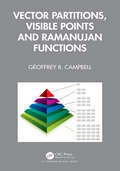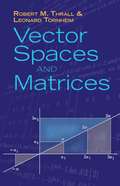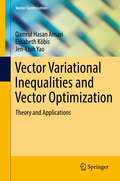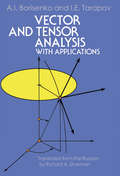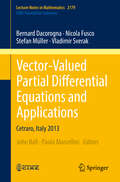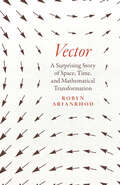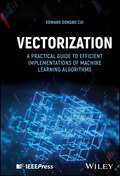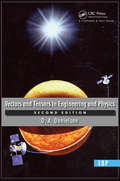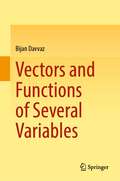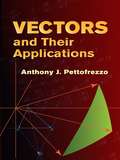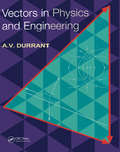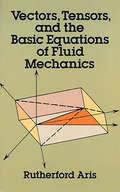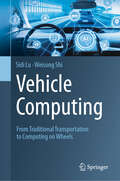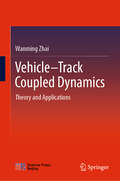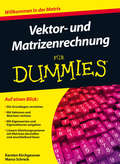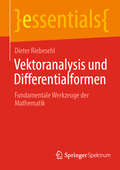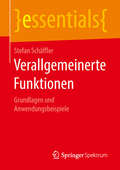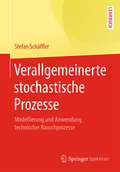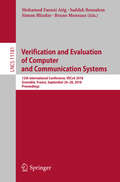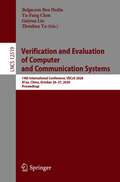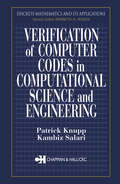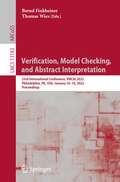- Table View
- List View
Vector Partitions, Visible Points and Ramanujan Functions
by Geoffrey B. CampbellVector Partitions, Visible Points and Ramanujan Functions offers a novel theory of Vector Partitions, though very much grounded in the long-established work of others, that could be developed as an extension to the existing theory of Integer Partitions. The book is suitable for graduate students in physics, applied mathematics, number theory and computational mathematics. It takes the reader up to research level, presenting new results alongside known classical results from integer partitions and areas of vector and multipartite partition theory. It also sets forth new directions for research for the more advanced reader.Above all, the intention of the book is to bring new inspiration to others who study mathematics and related areas. It is hoped that some new ideas will be launched to add value and insight into many of the classical and new theories surrounding partitions. The book is an appreciation of the many gifted authors of research into partitions over the past century and before, in the hope that more may come of this for future generations.Features Provides a step-by-step guide through the known literature on Integer and Vector Partitions, and a focus on the not so well-known Visible Point Vector identities Serves as a reference for graduate students and researchers in physics, applied mathematics, number theory and computational mathematics Offers a variety of practical examples as well as sets of exercises suitable for students and researchers Geoffrey B. Campbell completed his PhD at Australian National University in 1998 under the esteemed physicist Professor Rodney Baxter. His affiliation with the Australian National University Mathematical Sciences Institute has continued for over 30 years. Within that time frame, Geoffrey also served eight years as an Honorary Research Fellow at LaTrobe University Mathematics and Statistics Department in Melbourne. Currently he writes ongoing articles for the Australian Mathematical Society Gazette. Within the international scope, Geoffrey currently serves as a PhD external committee member for a mathematics graduate student at Washington State University in America.Geoffrey has built a career within Australian Commonwealth and State government departments, including as an Advisor at the Department of Prime Minister and Cabinet; as Analyst Researcher for a Royal Commission. Geoffrey specializes in complex data, machine learning including data analytics. He is also a published poet in Australian anthologies and literary magazines.
Vector Spaces and Matrices
by Leonard Tornheim Robert M. ThrallThis volume is suitable as a primary or supplementary text for college-level courses in linear algebra. It possesses the distinct advantage of approaching the subject simultaneously at two levels, the concrete and the axiomatic. Students thus receive the benefits of axiom-based mathematical reasoning as well as a grasp of concrete formulations. 1957 edition.
Vector Variational Inequalities and Vector Optimization
by Qamrul Hasan Ansari Jen-Chih Yao Elisabeth KöbisThis book presents the mathematical theory of vector variational inequalities and their relations with vector optimization problems. It is the first-ever book to introduce well-posedness and sensitivity analysis for vector equilibrium problems. The first chapter provides basic notations and results from the areas of convex analysis, functional analysis, set-valued analysis and fixed-point theory for set-valued maps, as well as a brief introduction to variational inequalities and equilibrium problems. Chapter 2 presents an overview of analysis over cones, including continuity and convexity of vector-valued functions. The book then shifts its focus to solution concepts and classical methods in vector optimization. It describes the formulation of vector variational inequalities and their applications to vector optimization, followed by separate chapters on linear scalarization, nonsmooth and generalized vector variational inequalities. Lastly, the book introduces readers to vector equilibrium problems and generalized vector equilibrium problems. Written in an illustrative and reader-friendly way, the book offers a valuable resource for all researchers whose work involves optimization and vector optimization.
Vector and Tensor Analysis with Applications
by Richard A. Silverman A. I. Borisenko I. E. TarapovConcise and readable, this text ranges from definition of vectors and discussion of algebraic operations on vectors to the concept of tensor and algebraic operations on tensors. It also includes a systematic study of the differential and integral calculus of vector and tensor functions of space and time. Worked-out problems and solutions. 1968 edition.
Vector-Valued Partial Differential Equations and Applications
by Stefan Müller Bernard Dacorogna Nicola Fusco Vladimir Sverakjohn Ball Paolo MarcelliniCollating different aspects of Vector-valued Partial Differential Equations and Applications, this volume is based on the 2013 CIME Course with the same name which took place at Cetraro, Italy, under the scientific direction of John Ball and Paolo Marcellini. It contains the following contributions: The pullback equation (Bernard Dacorogna), The stability of the isoperimetric inequality (Nicola Fusco), Mathematical problems in thin elastic sheets: scaling limits, packing, crumpling and singularities (Stefan M#65533;ller), and Aspects of PDEs related to fluid flows (Vladimir Sver#65533;k). These lectures are addressed to graduate students and researchers in the field.
Vector: A Surprising Story of Space, Time, and Mathematical Transformation
by Robyn ArianrhodA celebration of the seemingly simple idea that allowed us to imagine the world in new dimensions—sparking both controversy and discovery. The stars of this book, vectors and tensors, are unlikely celebrities. If you ever took a physics course, the word “vector” might remind you of the mathematics needed to determine forces on an amusement park ride, a turbine, or a projectile. You might also remember that a vector is a quantity that has magnitude and (this is the key) direction. In fact, vectors are examples of tensors, which can represent even more data. It sounds simple enough—and yet, as award-winning science writer Robyn Arianrhod shows in this riveting story, the idea of a single symbol expressing more than one thing at once was millennia in the making. And without that idea, we wouldn’t have such a deep understanding of our world. Vector and tensor calculus offers an elegant language for expressing the way things behave in space and time, and Arianrhod shows how this enabled physicists and mathematicians to think in a brand-new way. These include James Clerk Maxwell when he ushered in the wireless electromagnetic age; Einstein when he predicted the curving of space-time and the existence of gravitational waves; Paul Dirac, when he created quantum field theory; and Emmy Noether, when she connected mathematical symmetry and the conservation of energy. For it turned out that it’s not just physical quantities and dimensions that vectors and tensors can represent, but other dimensions and other kinds of information, too. This is why physicists and mathematicians can speak of four-dimensional space-time and other higher-dimensional “spaces,” and why you’re likely relying on vectors or tensors whenever you use digital applications such as search engines, GPS, or your mobile phone. In exploring the evolution of vectors and tensors—and introducing the fascinating people who gave them to us—Arianrhod takes readers on an extraordinary, five-thousand-year journey through the human imagination. She shows the genius required to reimagine the world—and how a clever mathematical construct can dramatically change discovery’s direction.
Vectorization: A Practical Guide to Efficient Implementations of Machine Learning Algorithms
by Edward DongBo CuiEnables readers to develop foundational and advanced vectorization skills for scalable data science and machine learning and address real-world problems Offering insights across various domains such as computer vision and natural language processing, Vectorization covers the fundamental topics of vectorization including array and tensor operations, data wrangling, and batch processing. This book illustrates how the principles discussed lead to successful outcomes in machine learning projects, serving as concrete examples for the theories explained, with each chapter including practical case studies and code implementations using NumPy, TensorFlow, and PyTorch. Each chapter has one or two types of contents: either an introduction/comparison of the specific operations in the numerical libraries (illustrated as tables) and/or case study examples that apply the concepts introduced to solve a practical problem (as code blocks and figures). Readers can approach the knowledge presented by reading the text description, running the code blocks, or examining the figures. Written by the developer of the first recommendation system on the Peacock streaming platform, Vectorization explores sample topics including: Basic tensor operations and the art of tensor indexing, elucidating how to access individual or subsets of tensor elementsVectorization in tensor multiplications and common linear algebraic routines, which form the backbone of many machine learning algorithmsMasking and padding, concepts which come into play when handling data of non-uniform sizes, and string processing techniques for natural language processing (NLP)Sparse matrices and their data structures and integral operations, and ragged or jagged tensors and the nuances of processing them From the essentials of vectorization to the subtleties of advanced data structures, Vectorization is an ideal one-stop resource for both beginners and experienced practitioners, including researchers, data scientists, statisticians, and other professionals in industry, who seek academic success and career advancement.
Vectors And Tensors In Engineering And Physics: Second Edition
by Donald DanielsonVectors and Tensors in Engineering and Physics develops the calculus of tensor fields and uses this mathematics to model the physical world. This new edition includes expanded derivations and solutions, and new applications. The book provides equations for predicting: the rotations of gyroscopes and other axisymmetric solids, derived from Euler's equations for the motion of rigid bodies; the temperature decays in quenched forgings, derived from the heat equation; the deformed shapes of twisted rods and bent beams, derived from the Navier equations of elasticity; the flow fields in cylindrical pipes, derived from the Navier-Stokes equations of fluid mechanics; the trajectories of celestial objects, derived from both Newton's and Einstein's theories of gravitation; the electromagnetic fields of stationary and moving charged particles, derived from Maxwell's equations; the stress in the skin when it is stretched, derived from the mechanics of curved membranes; the effects of motion and gravitation upon the times of clocks, derived from the special and general theories of relativity. The book also features over 100 illustrations, complete solutions to over 400 examples and problems, Cartesian components, general components, and components-free notations, lists of notations used by other authors, boxes to highlight key equations, historical notes, and an extensive bibliography.
Vectors and Functions of Several Variables
by Bijan DavvazThis comprehensive textbook explores the topics of vector functions and functions of several variables. With over 500 exercises and problems, carefully chosen for their challenging, interesting, and educational value, this book is an ideal resource for undergraduate students of mathematics, statistics, computer science, engineering and the basic sciences. The material is organized into 10 chapters, each of which begins with necessary definitions, concepts and theorems to provide a solid foundation for understanding the topic. In addition, the book includes detailed solutions to all exercises and problems to help students test their understanding and reinforce their learning. Overall, this book is an excellent choice for anyone seeking a thorough introduction to calculus.
Vectors and Their Applications (Dover Books on Mathematics)
by Anthony J. PettofrezzoGeared toward undergraduate students, this text illustrates the use of vectors as a mathematical tool in plane synthetic geometry, plane and spherical trigonometry, and analytic geometry of two- and three-dimensional space. Its rigorous development includes a complete treatment of the algebra of vectors in the first two chapters.Among the text's outstanding features are numbered definitions and theorems in the development of vector algebra, which appear in italics for easy reference. Most of the theorems include proofs, and coordinate position vectors receive an in-depth treatment. Key concepts for generalized vector spaces are clearly presented and developed, and 57 worked-out illustrative examples aid students in mastering the concepts. A total of 258 exercise problems offer supplements to theories or provide the opportunity to reinforce the understanding of applications, and answers to odd-numbered exercises appear at the end of the book.
Vectors in Physics and Engineering
by Alan DurrantThis text is an introduction to the use of vectors in a wide range of undergraduate disciplines. It is written specifically to match the level of experience and mathematical qualifications of students entering undergraduate and Higher National programmes and it assumes only a minimum of mathematical background on the part of the reader. Basic mathematics underlying the use of vectors is covered, and the text goes from fundamental concepts up to the level of first-year examination questions in engineering and physics. The material treated includes electromagnetic waves, alternating current, rotating fields, mechanisms, simple harmonic motion and vibrating systems. There are examples and exercises and the book contains many clear diagrams to complement the text. The provision of examples allows the student to become proficient in problem solving and the application of the material to a range of applications from science and engineering demonstrates the versatility of vector algebra as an analytical tool.
Vectors, Pure and Applied
by T. W. KornerMany books in linear algebra focus purely on getting students through exams, but this text explains both the how and the why of linear algebra and enables students to begin thinking like mathematicians. The author demonstrates how different topics (geometry, abstract algebra, numerical analysis, physics) make use of vectors in different ways and how these ways are connected, preparing students for further work in these areas. The book is packed with hundreds of exercises ranging from the routine to the challenging. Sketch solutions of the easier exercises are available online.
Vectors, Tensors and the Basic Equations of Fluid Mechanics
by Rutherford ArisThis introductory text is geared toward engineers, physicists, and applied mathematicians at the advanced undergraduate and graduate levels. It applies the mathematics of Cartesian and general tensors to physical field theories and demonstrates them chiefly in terms of the theory of fluid mechanics. Numerous exercises appear throughout the text. 1962 edition.
Vehicle Computing: From Traditional Transportation to Computing on Wheels
by Weisong Shi Sidi LuOver the past century, vehicles have predominantly functioned as a means of transportation. However, as vehicular computation and communication capacities continue to expand, it is anticipated that upcoming connected vehicle (CVs) will not only serve their conventional transport functions but also act as versatile mobile computing platforms. This book presents the concept of Vehicle Computing, encompassing five primary functionalities of CVs: computation, communication, energy management, sensing, and data storage. It proposes a potential business model and explores the challenges and opportunities associated with these domains. Vehicle Computing serves as an important resource for the research community and practitioners in the field of edge computing and cyber physical system, capturing the essence of a rapidly changing industry, addressing the challenges and opportunities associated with connected vehicles (including software-defined vehicles, autonomous vehicles, electric vehicles), machine learning, communication, sensing, data storage, energy management, and computer systems. It synthesizes the latest research and real-world applications, offering valuable insights to both academia and industry professionals. Vehicle Computing covers topics such as: The fundamentals of Vehicle Computing, including its historical context and key components. Advanced communication and networking technologies for connected vehicles. Sensing and data acquisition techniques, including edge and cloud computing integration. Energy management and storage, focusing on electric vehicle infrastructure and vehicle-to-grid. Data storage and processing strategies for vehicular environments. Business models, opportunities, and challenges associated with Vehicle Computing. Real-world applications and case studies, highlighting best practices and future trends.
Vehicle Dynamics of Modern Passenger Cars (CISM International Centre for Mechanical Sciences #582)
by Peter LugnerThe book provides the essential features necessary to understand and apply the mathematical-mechanical characteristics and tools for vehicle dynamics including control mechanism. An introduction to passenger car modeling of different complexities provides the basics for the dynamical behavior and presents vehicle models later used for the application of control strategies. The presented modeling of the tire behavior, also for transient changes of the contact patch properties, shows the necessary mathematical descriptions used for the simulation of the vehicle dynamics. The introduction to control for cars and its extension to complex applications using e.g. observers and state estimators is a main part of the book. Finally the formulation of proper multibody codes for the simulation leads to the integration of all parts. Examples of simulations and corresponding test verifications show the profit of such a theoretical support for the investigation of the dynamics of passenger cars.
Vehicle–Track Coupled Dynamics: Theory and Applications
by Wanming ZhaiThis book systematically presents the theory, numerical implementation, field experiments and practical engineering applications of the ‘Vehicle–Track Coupled Dynamics’. Representing a radical departure from classic vehicle system dynamics and track dynamics, the vehicle–track coupled dynamics theory considers the vehicle and track as one interactive and integrated system coupled through wheel–rail interaction. This new theory enables a more comprehensive and accurate solution to the train–track dynamic interaction problem which is a fundamental and important research topic in railway transportation system, especially for the rapidly developed high-speed and heavy-haul railways. It has been widely applied in practical railway engineering.Dr. Wanming Zhai is a Chair Professor of Railway Engineering at Southwest Jiaotong University, where he is also chairman of the Academic Committee and Director of the Train and Track Research Institute. He is a member of the Chinese Academy of Sciences and one of the leading scientists in railway system dynamics. Professor Zhai is Editor-in-Chief of both the International Journal of Rail Transportation, published by Taylor & Francis Group, and the Journal of Modern Transportation, published by Springer. In addition, he is a trustee of the International Association for Vehicle System Dynamics, Vice President of the Chinese Society of Theoretical and Applied Mechanics, and Vice President of the Chinese Society for Vibration Engineering.
Vektor- und Matrizenrechnung fur Dummies (Für Dummies)
by Marco Schreck Karsten KirchgessnerWas Sie wissen müssen – von Abbildungsmatrix bis Zylinderkoordinaten Ganz egal, was Sie machen wollen, in der Mathematik führt ab einem gewissen Niveau kein Weg an der Vektorund Matrizenrechnung vorbei. Karsten Kirchgessner und Marco Schreck führen Sie in dieses Thema ein. Sie erklären Ihnen, was Vektoren und Matrizen überhaupt sind und wie Sie möglichst unkompliziert mit ihnen rechnen. Außerdem erfahren Sie, was Sie über Eigenwerte und Eigenvektoren wissen sollten, wie Sie lineare Gleichungssysteme lösen und vieles mehr. So lernen Sie pfeilschnell, in diese Tiefen der Mathematik einzudringen. Besonderer Wert wird hierbei auf geschickte Ansätze und Tricks gelegt, die den Rechenaufwand und Komplexitätsgrad einer Aufgabenstellung reduzieren, sodass Sie insbesondere in Prüfungen so schnell wie möglich zur korrekten Lösung gelangen.
Vektoranalysis und Differentialformen: Fundamentale Werkzeuge der Mathematik (essentials)
by Dieter RiebesehlDieter Riebesehl schlägt in diesem essential die Brücke von der klassischen Vektoranalysis zum Formalismus der Differentialformen. Die Vektoranalysis behandelt Vektorfelder, meist im zwei- oder dreidimensionalen Raum, und ist ein grundlegendes Werkzeug für Physiker, Ingenieure und Techniker. Die zentralen Definitionen werden sorgfältig motiviert und dann die wichtigsten Aussagen bis hin zu den Integralsätzen von Gauß und Stokes hergeleitet. Die Darstellung ist möglichst elementar und vermeidet darüberhinausgehende Konzepte wie Mannigfaltigkeiten. Die Vektoranalysis hat einen gewissen Mangel an Eleganz, der sich darin äußert, dass sie sich nicht leicht auf mehr als drei Dimensionen verallgemeinern lässt und unnötig viele ähnliche Konzepte verwendet. Die Sprache der Differentialformen kommt mit weniger Konzepten aus, ermöglicht besonders knappe Formulierungen der Integralsätze und ist leicht auf beliebige Dimensionen verallgemeinerbar. In diesem essential wird die Übersetzung der Vektoranalysis in die Sprache der Differentialformen anschaulich und die Eleganz der neuen Formulierung deutlich gemacht.
Vender A Través de Tu Corazón: Empoderándote Para Construir Relaciones Hacia la Libertad Financiera
by PhD Shirlene ReevesVender A Través de Tu Corazón es el libro 4 veces galardonado a nivel internacional de mayor venta, que te permite desarrollar relaciones para tu libertad financiera. Este libro es reconocido mundialmente como una codiciada guía paso a paso para construir negocios multimillonarios y está diseñado exclusivamente para propietarios de pequeñas empresas, vendedores y empresarios. Dentro de sus páginas, los lectores descubren cómo desarrollar una mentalidad de abundancia, aprenden a comunicarse con los demás de manera efectiva y construir una base sólida para cualquier negocio en alza. También enseña paso a paso cómo comercializar de manera efectiva productos y servicios y venderlos utilizando la estrategia de los 3 Step Sales Waltz ™ (3 pasos de las Ventas de Vals ™) de la Dra. Shirlene. En este libro, recibirás el conocimiento para: Diseñar tu plan de negocios. Descubrir los secretos para convertirte en un anfitrión experto de medios en podcasts, televisión por internet y radio. Convertirte en un líder comunitario efectivo. Construir relaciones duraderas y sinceras para excelentes referencias. Dominar el secreto de un flujo natural a través del proceso de ventas. Hacer networking efectivo para las ventas exitosas. Superar la objeción y el rechazo en las ventas sin ser agresivo. Vender auténticamente sin guiones ni sesiones de descubrimiento. Ganar dinero mientras duermes. "Considerarás este libro como una guía fácil de entender, ilustrada con historias que lo hacen identificable e interactivo. Me complace otorgar 4 de 4 estrellas a Vender A Través de Tu Corazón, Empoderándote para construir relaciones hacia la libertad financiera. Seguramente será una guía de apoyo para dueños de negocios, vendedores, empresarios y cualquier persona que aspire a ser uno de estos". Kristy Kem - Comentario en Amazon También se incluye en Vender A Través de Tu Corazón, el plan en demanda de
Verallgemeinerte Funktionen: Grundlagen und Anwendungsbeispiele (essentials)
by Stefan SchäfflerDieses essential bietet eine Einführung in die theoretischen Grundlagen und Anwendungen der verallgemeinerten Funktionen. Nach zwei typischen Anwendungen verallgemeinerter Funktionen wird die Theorie entwickelt, wobei zum besseren Verständnis nur die fundamentalen Ideen vorgestellt werden, sodass keine funktionalanalytischen Kenntnisse vorausgesetzt werden. Danach folgt eine systemtheoretische Untersuchung von LTI-Systemen unter Einbeziehung der Dirac-Distribution und die Modellierung gezupfter schwingender Saiten. Den Abschluss bildet die Modellierung technischer Rauschprozesse am Beispiel des kontinuierlichen weißen Rauschens.
Verallgemeinerte stochastische Prozesse
by Stefan SchäfflerDieses Lehrbuch behandelt die in Natur- und Ingenieurwissenschaften eine zentrale Rolle spielenden Rauschprozesse, wie weißes Rauschen in der Raumsondenkommunikation oder thermisches Rauschen und Schrotrauschen in elektronischen Bauelementen.In dieser Form einzigartig, entwickelt der Autor die mathematische Theorie der verallgemeinerten stochastischen Prozesse und spricht dabei die Anwendung dieser mathematischen Objekte in der Praxis (z.B. Schaltkreissimulation, digitale Nachrichtenübertragung und Bildverarbeitung) an; somit dient dieses Lehrbuch auch als praxisrelevante Einführung in die Modellierung und Verwendung technischer Rauschprozesse. Die mathematische Modellierung von Rauschprozessen führt auf die Theorie stochastischer Prozesse auf Basis verallgemeinerter Funktionen (Distributionen), ohne die kein Handy funktionieren und Anwendungen wie die Simulation komplexer elektronischer Schaltungen unmöglich wäre.Für Anwender und interessierte Mathematiker bietet dieses Werk erstmals einen mathematisch fundierten Einblick in diese Thematik.
Verification and Evaluation of Computer and Communication Systems: 12th International Conference, VECoS 2018, Grenoble, France, September 26–28, 2018, Proceedings (Lecture Notes in Computer Science #11181)
by Mohamed Faouzi Atig Saddek Bensalem Simon Bliudze Bruno MonsuezThis book constitutes the proceedings of the 12th International Conference on Verification and Evaluation of Computer and Communication Systems ( VECoS 2018) held at Grenoble, France, in September 2018. The 11 full papers in this volume, presented together with one abstract and two invited papers, were carefully reviewed and selected from 23 submissions. The aim of the VECoS conference is to bring together researchers and practitioners in the areas of verification, control, performance, and dependability evaluation in order to discuss state of the art and challenges in modern computer and communication systems in which functional and extra-functional properties are strongly interrelated. Thus, the main motivation for VECoS is to encourage the cross-fertilization between various formal verification and evaluation approaches, methods and techniques, and especially those developed for concurrent and distributed hardware/software systems.
Verification and Evaluation of Computer and Communication Systems: 14th International Conference, VECoS 2020, Xi'an, China, October 26–27, 2020, Proceedings (Lecture Notes in Computer Science #12519)
by Yu-Fang Chen Belgacem Ben Hedia Gaiyun Liu Zhenhua YuThis book constitutes the proceedings of the 14th International Conference on Verification and Evaluation of Computer and Communication Systems, VECoS 2020, which was supposed to be held in Xi’an, China, in October 2020, but was held virtually instead. The 19 full papers and 1 short paper presented in this volume were carefully reviewed and selected from 60 submissions. The aim of the VECoS conference is to bring together researchers and practitioners in the areas of verification, control, performance, and dependability evaluation in order to discuss state of the art and challenges in modern computer and communication systems in which functional and extra-functional properties are strongly interrelated. Thus, the main motivation for VECoS is to encourage the cross-fertilization between various formal verification and evaluation approaches, methods and techniques, and especially those developed for concurrent and distributed hardware/software systems. The papers are organized in the following topical sections: petri-net, simulation, and scheduling; formal modeling and verification, testing; and artificial intelligence and machine learning.
Verification of Computer Codes in Computational Science and Engineering (Discrete Mathematics and Its Applications)
by Patrick Knupp Kambiz SalariHow can one be assured that computer codes that solve differential equations are correct? Standard practice using benchmark testing no longer provides full coverage because today's production codes solve more complex equations using more powerful algorithms. By verifying the order-of-accuracy of the numerical algorithm implemented in the code, one can detect most any coding mistake that would prevent correct solutions from being computed.Verification of Computer Codes in Computational Science and Engineering sets forth a powerful alternative called OVMSP: Order-Verification via the Manufactured Solution Procedure. This procedure has two primary components: using the Method of Manufactured Exact Solutions to create analytic solutions to the fully-general differential equations solved by the code and using grid convergence studies to confirm the order-of-accuracy. The authors present a step-by-step procedural guide to OVMSP implementation and demonstrate its effectiveness.Properly implemented, OVMSP offers an exciting opportunity to identify virtually all coding 'bugs' that prevent correct solution of the governing partial differential equations. Verification of Computer Codes in Computational Science and Engineering shows you how this can be done. The treatment is clear, concise, and suitable both for developers of production quality simulation software and as a reference for computational science and engineering professionals.
Verification, Model Checking, and Abstract Interpretation: 23rd International Conference, VMCAI 2022, Philadelphia, PA, USA, January 16–18, 2022, Proceedings (Lecture Notes in Computer Science #13182)
by Bernd Finkbeiner Thomas WiesThis book constitutes the proceedings of the 23rd International Conference on Verification, Model Checking, and Abstract Interpretation, VMCAI 2022, which took place in Philadelphia, PA, USA, in January 2022.The 22 papers presented in this volume were carefully reviewed from 48 submissions. VMCAI provides a forum for researchers working on verification, model checking, and abstract interpretation and facilitates interaction, cross-fertilization, and advancement of hybrid methods that combine these and related areas.
